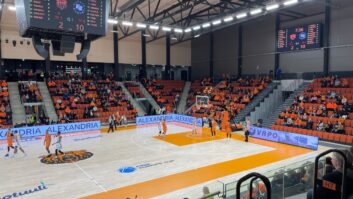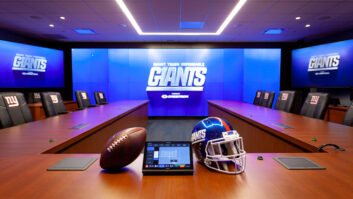Displays were prominent at ISE last month. Ian McMurray looks at some of the up-and-coming technologies in the market and assesses their potential impact on the incumbents
Once upon a time, a major company invested hundreds of millions of dollars developing a new display technology designed to power future generations of televisions. The thinking was that this technology could deliver images of a quality substantially superior to those available from competing slim TV technologies at a lower price – and would thus become a dominant force.
For a brief time, it possibly was. Fast-forward a number of years, and TVs featuring that technology are harder to find than hen’s teeth. The speed with which competing technologies improved their image quality while reducing costs was incredible to behold. The moral of the story? You underestimate incumbent display technologies, and their manufacturers, at your – considerable – risk.
At ISE, there was no shortage of interest for industry display-watchers – and plenty of evidence of incumbent technologies raising their game. In terms of new technologies, though, it perhaps wasn’t surprising that there was no sign of FED (Filed Emissive Display) or SED (Surface-conduction Electron-emitter Display). There was, however, Prysm’s LPD (Laser Phosphor Display) technology, making its European debut. Centre stage on the Mitsubishi stand was a prototype 149in OLED screen. Elsewhere, Christie had done some interesting things using existing technologies with its MicroTiles display. What these did was to raise the question of exactly what constitutes ‘new’?
“These are more than just new versions of existing products; they are completely new classes of display with specific qualities that make them quite exciting developments,” says Peter van Dijk, business manager for Mitsubishi Electric Benelux. “The arrival of new technologies always brings new applications so I think the next couple of years will be interesting.”
It’s not just about new classes of display, however. As influential in driving market growth are improvements in LCD, plasma and LED, which are making them more attractive, more flexible, more durable, more user-friendly, more cost-effective and more environmentally friendly.
Take LED technology, for example. There was a time when LED simply meant large, high-brightness, outdoor displays. But now, LED is being widely implemented as a backlight technology for LCD displays – and as a lamp replacement in front-projection and rear-projection systems. At the same time, there is a significant effort to extend the reach of LED panels.
“Yes, pixel pitches are becoming smaller and mountings more flexible, and creating new opportunities,” says Curie Chan, senior product manager at Lighthouse. “Panels are becoming lighter and slimmer, using less power and becoming capable of extended lifetimes. Add to those improvements the inherent robustness of LED panels, and it’s easy to see why the market for LED installations continues to grow rapidly.”
Future projections
LED technology is revolutionising the projector market, with much focus on its impact on total cost of ownership (and its green credentials) compared with the traditional mercury-based lamp. Samsung entered the fray at ISE with its DP-FM10, which the company claimed is the first LED-based projector capable of delivering 1,000 lumens (brightness being the key disadvantage of LED technology compared with lamps) – but LED is also breathing new life into the rear-projection market, according to Eric Hénique, director of marketing and international sales at eyevis. “LED illumination gives much more accurate, stable colour behaviour with colour temperature and is much easier to adjust,” he says. “This, combined with the extended lifetime of LED illumination – making a cube almost maintenance-free – and the thinner bezels that are possible, means that rear-projection cubes are still unrivalled for professional videowall applications.”
For years now, pundits have been forecasting the demise of rear-projection technology as flat-panel technologies have improved in almost every respect – but it still occupies a significant niche. “If you need the flexibility to precisely vary the image size, there is no competition for rear projection,” says Ed Martin, technical manager at PSCo.
Niche market
“For the right application, and in the right environment, rear projection is far from dead,” notes Joe Graziano, market development manager at Christie. “We’re currently experiencing what is probably the best time ever in our command and control business, which is based on rear projection and LED illumination.”
Also based on rear projection are the MicroTiles for which Graziano has market development responsibility. These combine LED illumination technology with a DLP projection engine and an inter-display gap of only 1mm to deliver a videowall experience that attracted praise from numerous ISE visitors. “This new display technology gives creative minds such as architects or content designers a completely new way of thinking about content and messaging,” adds Graziano.”
“Products such as MicroTiles, and potentially Prysm’s LPD, together with ultra-narrow bezel LCD technology, are eroding the dominance of rear projection,” says Chris McIntyre-Brown, Futuresource research consultant, “but the advent of LED illumination, superior colorimetry and bezel-less designs, along with techniques such as edge blending and the superior price/performance of cubes mean that rear projection will be around for a while.”
Discussion of the inroads that flat-panel technologies have made into rear-projection territory leads inevitably to talk of whether LCD or plasma is likely to prove dominant in the longer term. Judging by the evidence at ISE, it’s hard to believe plasma has a future, given the abundance of LCD displays. “Most major manufacturers have pulled out of plasma,” says Neale Williams, business development manager for digital media and cinema products at NEC Display Solutions. “LCD technology continues to grow in popularity as the preferred medium for displays. This is due to the lower cost of production and lower running costs. This, coupled with the advantage of lower image retention, gives LCD a major advantage over plasma.”
“As LCD technology improves, so we expect it to progressively displace plasma in videowall applications,” adds Hénique. “It has compelling advantages in terms of its narrow bezel, its lower power consumption and its better thermal load.”
“Plasma isn’t dead – at least not yet,” says van Dijk. “However, the role for plasma is decreasing year by year. Plasma can produce exceptional performance, but in commercial applications factors such as resistance to image sticking, robustness and longevity are often far more important. LCD performs better in these areas, so it’s no surprise that its market penetration is deeper.”
Opportunities remain
“Not true at all,” ripostes Daniel Rose, category manager at Panasonic Professional Projector & Display Europe, in response to those who claim plasma is on its way out. “For the largest sizes, where the highest growth is set to occur, PDP is just the right technology due to the higher quality of the images in terms of both colour and how it handles movement. It’s proving very difficult for competitors to approach the quality of PDP with LCD technology.
“Also, we’ll see a profusion of 3D installs this year – and experts agree that PDP is the only display technology that offers acceptable 3D performance at a commercial level. Some people have labelled this the revenge of PDP.”
“A major focus of screen manufacturers this year is the delivery of 3D-capable screens, and while both technologies are capable of delivering 3D, plasma has the potential for better performance,” agrees Martin. “Orion’s Infinite Plasma is still the slimmest flat-panel videowall display product. OLED, SED, LPD, or even LCD may one day compete for this, but there was nothing at ISE to suggest it will happen imminently.”
Rose and McIntyre-Brown are certainly not the only ones to believe that, if plasma needs a shot in the arm, it may well be the advent of 3D that administers it. “I hear clients talk about 3D rejuvenating plasma,” says McIntyre-Brown, “but I think the jury is still out.”
He doesn’t disagree with Rose, however, about where the growth in the displays market will be – although there is a grey area as to what constitutes ‘large’. For Rose, it’s the segment of the market somewhat above 55in – and there, plasma’s position does seem secure. But beyond that? “Panasonic has consistently demonstrated its ability to produce very large screens – like the 103in and the 85in – and is likely to continue to do so,” says McIntyre-Brown.
But even there, LCD isn’t the only player. “We’re expecting real growth in the very largest sizes,” rejoins Rose. “In the case of the 85in, we’re seeing some out-of-home projects using these displays to replace static 6-sheet posters. We’re also seeing projects pick up at point of sale in retail flagship stores – and we’re experiencing a recovery in the rental market, particularly for events.”
And while size is important, resolution, in many applications, is no less so. Eyevis’s 64in EYE-LCD6400-4K LCD display is, it seems, unique in its ability to deliver a resolution of 4,096 x 2,160 pixels.
But, perhaps, if digital signage is such a key market driver, neither plasma nor LCD will prevail – at least, not if Christie has its way. Graziano explains: “Consumers are very familiar with today’s flat-panel displays. On the one hand, that makes for a certain comfort level, but on the other, a display just becomes ‘noise’ and is easily disregarded. There’s an opportunity for a display technology that’s really capable of catching the eye, especially one that isn’t limited to the usual rectangle.”
If 3D is one external factor that may have an impact on which display technologies succeed and which fall by the wayside, another is the increasing use of interactivity. “With the launch of Windows 7 late last year,” says Williams, “we can expect to see the increased development of multi-touch devices.”
Multiple options
“We’ve recently added a multi-touch option to our Seventy Series cube range,” says van Dijk, “and there are other technologies coming forward, such as gesture recognition, that have interesting possibilities in commercial applications.”
While the ability to reproduce 3D is an inherent capability of a display technology, touch and gesture are more peripheral: there seems little reason why interactivity will favour one technology over another. That said, a display technology that makes interactivity easier could well have a future.
There is one other factor that might have a significant impact on the success or failure of the various display technologies: how green it is. At ISE, numerous exhibitors brought their environmental credentials to the fore. Samsung’s stand featured a demonstration showing how LED backlighting substantially reduced the power consumption of LCD displays. Meanwhile, Prysm’s demonstration featured a small digital display showing how few watts an LPD panel consumed – said to be 75% less, on a per square inch basis, than competing displays.
Other concerns
“We have already seen a clear increase in tender documents including additional criteria for green issues,” notes McIntyre-Brown, “and these are typically power consumption-led. However, I’m sure that other non-TCO issues will be added over time, such as component materials, packaging, transportation – in other words, the complete carbon footprint of a product – and they’ll become increasingly important for systems integrators and value-added resellers.”
The latter point is confirmed by Martin. “We are always looking at the energy consumption of the products we sell and rent, as are the manufacturers,” he says. “With each generation of technology, we’ve generally seen improvements.
For example, we’re seeing the introduction of energy-saving features such as ambient light sensors.”
Cynics, of course, point out that green isn’t just good for the planet – it’s typically at least as good for the bottom line, whether manufacturer or user. But whatever the motivation, the displays industry is certainly responding positively.
Manufacturers such as Christie, eyevis, Lighthouse, Mitsubishi, NEC and Panasonic all have active programmes designed to improve their products, whether it’s removing hazardous substances such as lead or mercury, reducing overall carbon emissions or developing products with longer lifetimes that consume less power.
But what of OLED, SED and FED? Or Prysm’s LPD, come to that? Mitsubishi’s impressive OLED demonstration and Prysm’s compelling power consumption aside, is there room in the market for new display technologies? The answer appears to be ‘no’ – or at least, not for the foreseeable future. Both OLED and LPD still face significant challenges.
The displays market is a vibrant one, with the majority of participants expecting 2010 to be an excellent year – but will it be an excellent year for LCD, LED, plasma and rear projection? The incumbent display technologies are not only surviving, but thriving.
www.christiedigital.com
www.eyevis.de
www.futuresource-consulting.co.uk
www.lighthouse-tech.com
www.vis.mitsubishielectric.co.uk
www.nec-display-solutions.co.uk
www.panasonic.co.uk
www.prysm.com
www.psco.co.uk







